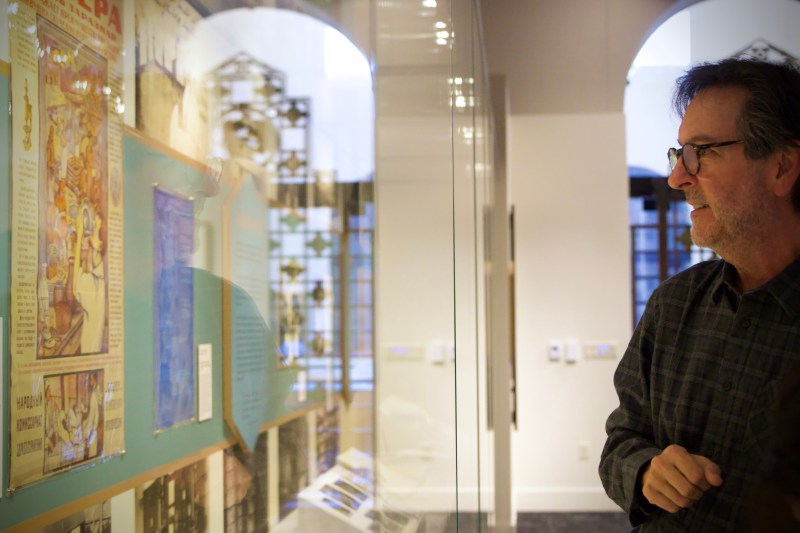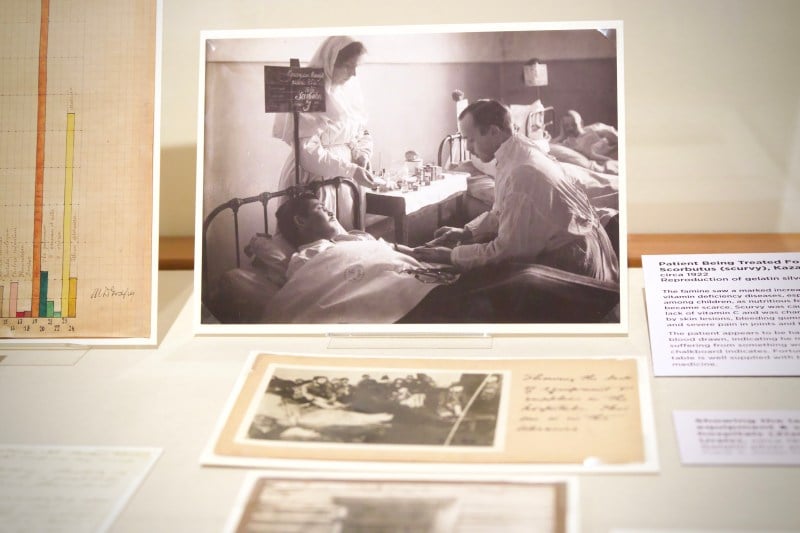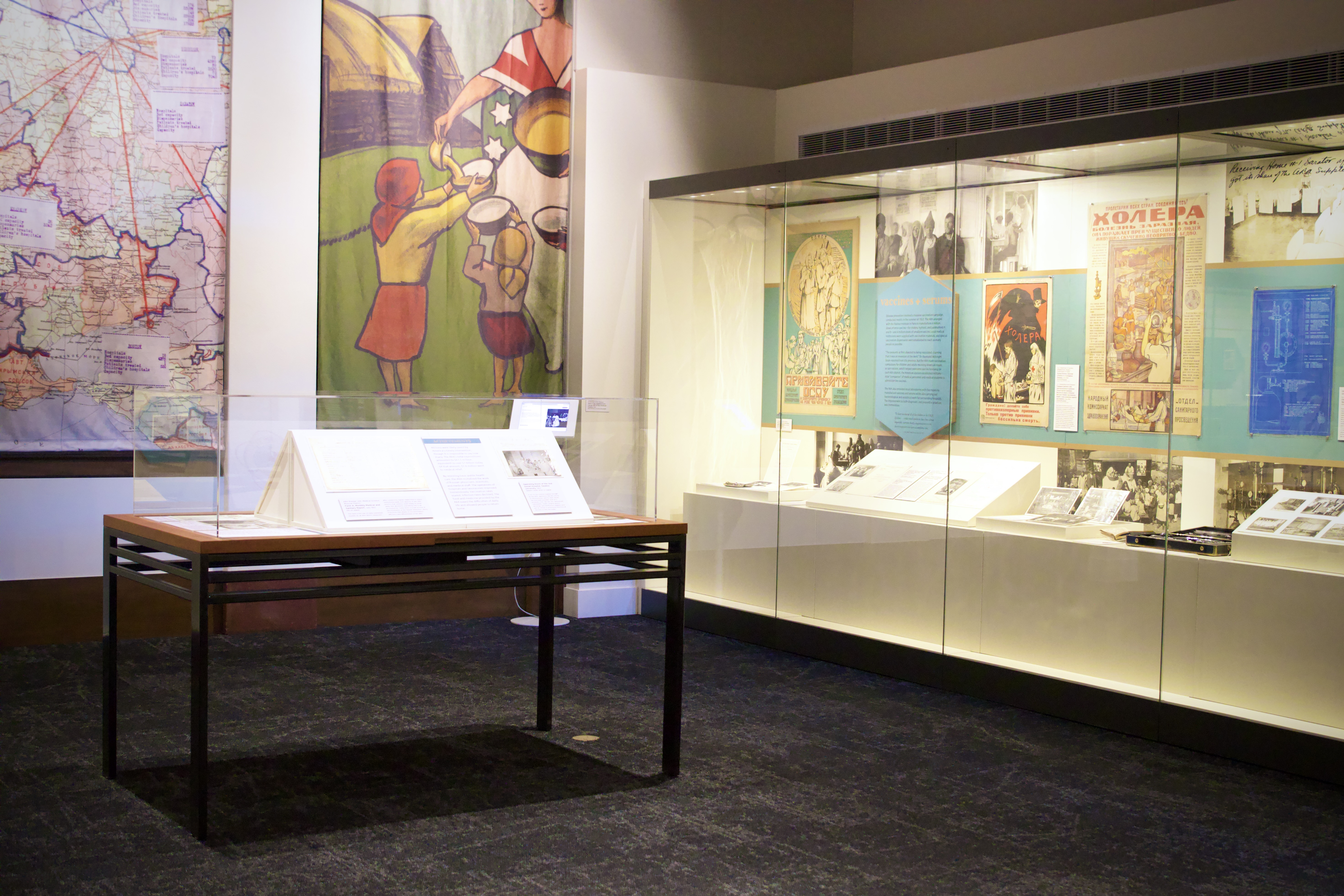“I ate my home,” reads the caption of a monochrome photo of scrawny children with swollen stomachs in front of a decrepit hut in Samara, Russia. Subsisting on a diet of tree bark, weeds and the hay thatchings on their roofs, these are the children of the Russian famine of 1921-1922.
The Hoover Institution’s latest exhibit, “Bread + Medicine,” tells the story of the United States’ role in delivering food relief and medical supplies to Soviet Russia and Ukraine. The exhibition commemorates the centennial anniversary of the American Relief Administration’s (ARA) humanitarian aid program in Soviet Russia and Ukraine under the leadership of former president Herbert Hoover, class of 1895.
“Bread + Medicine” aims to shed light on the twin aspects of food relief and medical supplies that defined the American relief program directed by Herbert Hoover. “People living through famine don’t die of hunger, they die of hunger-related diseases,” exhibit curator and Hoover Institution research fellow Bertrand Patenaude told The Daily. More recent studies confirm that disease is a significant cause of casualties during famine.
Located at the ground floor gallery of the Hoover Tower, the exhibit pieces together disparate archival materials to share a narrative of inter-state collaboration during a humanitarian crisis. On one side of the room are photos of the 30 American doctors who worked alongside Russian staff to address the “medical famine,” securing $600,000 worth of American Red Cross supplies and mobilizing a widespread vaccination campaign, according to the exhibit. Across the room are the same doctors’ diaries and papers confessing the desperate, destitute conditions of local medical institutions.

“It’s like putting together a puzzle that keeps evolving,” Patenaude said, referring to the ongoing curation process. “Many documents haven’t been uncovered since they were first shelved decades ago, while other materials, like Dr. John Toole’s diary, were acquired as recently as 2019.”
“Bread + Medicine” includes both a physical and virtual component. The physical exhibit draws on over 600 boxes of ARA papers, Soviet posters and 4,000 photos housed in the Hoover archives. The forthcoming online exhibit will include over 2,000 digitized materials and original student work from a directed reading course taught by Patenaude at the Archives last year. The exhibit is the result of “nearly two years of planning and a year and a half of careful digitization and preservation,” Hoover Institution outreach manager Samira Bozorgi told The Daily.
The ARA, a government agency founded after World War I to provide critical food relief to a war-torn Europe, conducted “the single largest humanitarian effort in American history,” Patenaude’s directed reading student Sorcha Whitley ’23 told The Daily. In actuality, recent humanitarian efforts — such as that for the COVID-19 pandemic — exceed the ARA’s budget when adjusted for inflation, though the mission was the largest ever at the time.
According to Whitley, the work of the ARA is largely overlooked and overshadowed by more dominant narratives of unimpeachable U.S.-Soviet animosity during the 20th century. “It’s an important part of U.S. history, but it doesn’t fit neatly into the broad historical narrative, so unless you go looking for it, you’re unlikely to find it,” Whitley said. Whitley’s research on the ARA’s food remittance program will be published in the winter issue of the Hoover Digest.
Scholarship tends to agree with the exhibit’s assessment of the facts. Herbert Hoover scholar Benjamin M. Weissman wrote that while there were disputes during the mission, mainly over the immunity of American workers in Soviet territory, its impact was positive. Hoover’s motivation (as revealed by a secret message to a subordinate) was purely humanitarian, even if he had previously used ARA resources to support anti-communist regimes in the region.
For those familiar with the history of the ARA, the exhibit’s specific focus on the medical aspect of the Soviet mission may come as a surprise; the organization’s food relief program was much more extensive than its medical counterpart, providing nearly 11 million meals each day at its peak. In fact, the ARA’s primary mission was to deliver food and only later sub-branched to medical relief during the typhus epidemic, according to the exhibit.

Furthermore, Congress secured $20,000,000 of funding for the Soviet relief effort against the backdrop of the First Red Scare and Hoover’s own ardent anti-Bolshevism; this story was not discussed in the exhibit.
Nonetheless, the exhibit’s incorporation of Soviet documents and posters reveals the gratitude of the hungry and the sick for the ARA. Whitley remembered gaining “an appreciation for the individual impact of the ARA’s efforts after reading through boxes and boxes of letters from Soviet citizens thanking the American people for rescuing them from starvation and death.”
For some, the exhibit documents the potential for inter-state collaboration in humanitarian crises even amidst geopolitical tensions and disagreements. Whitley concluded that while ARA’s successful humanitarian mission “does not eliminate or overwrite the darker parts of American history,” it is still “a reminder that the U.S. has done good in the world, and that it still can.”
“I think a lot of people don’t realize how broad the Hoover Institute umbrella is. There are a lot of Hoover Fellows who produce work that doesn’t really mesh with the reputation of the Institute, or support its political goals,” Whitley said in reference to the Hoover Institute’s conservative leaning.
